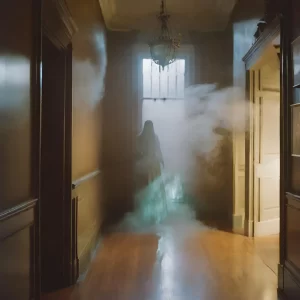Pioneer Village

Want to see the Old West for yourself? Pioneer Village is as close as it gets. Located on a 90-acre plot north of Phoenix, the living museum is a mix of original buildings and replicas of historic structures from the early days of the Southwest. Pioneer Village is a reconstruction of an old western town, meant to portray daily life for those who made the pilgrimage out west. The museum was founded in 1969 by the Pioneer Arizona Foundation Inc, a group of historians that wanted to save Arizona’s historical relics. The rapid development in and around the Phoenix area meant that many old historical sites were being razed, so the foundation had them moved to their current location to save them from destruction. It seems that when the buildings were moved, the ghosts came with them. The museum is haunted by the ghosts of the Wild West, and many of the original buildings have their own spirits attached to them. Guests and staff have heard voices and seen apparitions around the museum grounds.
Origins of the Pioneer Village
In 1956, a group of native Arizona history enthusiasts came together to form the Pioneer Arizona Foundation. The foundation included some well known Arizona residents, namely former governors and state senators. The Babbitt family, who helped build the Hotel San Marcos, also provided community support for the project. The foundation was concerned about how rapid development and growth around Phoenix was going to lead to the inevitable destruction of some of the area’s most precious historical relics, as some had already been lost.
The Pioneer Arizona Foundation focused on buildings that had been built between 1863 and 1912. They bought a 90 acre plot in an empty area of North Phoenix. The group relied on donations to move the buildings and restore them. They also reconstructed those that were already destroyed. The idea was to recreate a town center that resembled the early days of the Old West, to educate tourists and Phoenix area residents about settler life. They also wanted a hands-on experience to better educate children on the area’s history.
The museum opened in 1969, boasting 10 original structures and 15 recreations. Originally called the Pioneer Living History Museum, the name was eventually changed to Pioneer Village. The museum is alive with characters dressed in period clothing, as well as the occasional gun battle. They also do ghost tours at night.
Pioneer Village is still facing financial issues. There is a plan to expand the museum, but the funds have yet to be allocated. The actors and characters that work in the museum all do so on a volunteer basis, so being lucky enough to witness a gunfight is not always a guarantee.
Ghosts of Pioneer Village
A number of different ghosts haunts pioneer Village. Many of the original structures seem to have their own spirits attached to them. Though many ghosts seem to come out at night, visitors have caught glimpses in broad daylight.
Pioneer Village Saloon & Telephone Museum
At the front of the museum lies the Pioneer Village Saloon and Telephone Museum. They’re two distinct exhibits that share the same building. The Telephone Museum is a comprehensive exhibit on the history and evolution of the telephone. The saloon is a reconstruction of the WHIS saloon that once existed in Gila Bend, Arizona. Nicknamed “The Road to Ruin,” the Salvation Army bought the saloon around 1900 to combat alcoholism. The Salvation Army made the building their Phoenix area headquarters, changing the saloon’s name to “The Road to Heaven.” Not much is known about what happened to the building after the Salvation Army left. It may have found life as another bar, though some say it burned to the ground.
There are two spirits that like to haunt the Telephone Museum and Saloon. The ghost of a cowboy hangs out at the end of the bar in the saloon. He might be one of the bar’s original patrons or a wandering spirit that took refuge in the bar. The Telephone Museum has a ghost that likes to switch on the electronics and play with the switchboards. Some mediums say that antique electronics attract intelligent spirits who are interested in electronic gadgets and gizmos.
Pioneer Village Community Church
The Pioneer Village Community Church is a reconstruction of the St. Paul’s Episcopal Church in Globe, Arizona. The original church was built in 1880 for Methodists in the area. In 1927, the Methodist community had outgrown the church and was torn down; the lot was sold to a local telephone company. The Methodists saved the church bell, which they dubbed “God’s alarm clock.”
Two spirits, a male and female, inhabit the church. They might be attached to some of the original fixtures in the church. They may be a brother and sister who passed away due to misfortune and took residence in the church for comfort.
Merritt Farm
The Merritt Farm is one of the original structures in Pioneer Village. The house exists as it did during the early days of the Merritt family. The farm was established in 1910 when the Merritt family relocated to Arizona from Nevada. The family prospered, raising a wide array of livestock and growing an even wider variety of crops. The family lived on the farm until 2008, until Beryl Merritt decided to donate the farm, complete with all of its structures, to the Pioneer Village.
Two generations of the Merritt family lived on the farm before it was donated to the museum. At least nine ghosts live on the farm, most likely members of the Merritt family and family friends. The most visible spirit is a woman who has been seen by staff and guests holding a baby. Others include a young boy and girl and an older man who is not fond of visitors.
Victorian House
The Victorian House was one of the first homes in Phoenix with a completely wooden frame. When the house was built in the 1890s, timber was a hard commodity to come by, and most houses were built with adobe bricks. The house was acquired by John Marion Sears, a Confederate Army veteran who took up farming after moving to Arizona. When the home was donated in 1969, it was scheduled for demolition in just 30 days.
The ghost of Ms. Newman still lives in the Victorian House. The Newman family lived in the house after John Sears and left the home abandoned and dilapidated. A young boy also lives in the Victorian House. He’s been seen by guests and staff peering through the front windows.
Pioneer Village Sheriff’s Office & Jail
The Sheriff’s Office and Jail are a reconstruction of the adobe brick Gia County Courthouse and Globe Sheriff’s Office. The two jail cells each had two bunks, and the judge came for court hearings once a month. The jail was originally small due to the small population of Globe, Arizona. But over time, the cells became overcrowded, forcing police and city officials to construct more jail space.
The ghost of a prisoner who died in the jail can still be heard asking for help. On occasion, guests and staff hear the prisoner whispering into their ears, and some feel a cold spot while standing in the cell. The man died in police custody because they refused to give him proper medical treatment, an avoidable death that keeps his spirit restless. Another ghost is that of a police jailer. The ghost retains his authoritative spirit and highly disapproved of inmates playing cards to entertain themselves.
The Gordon School
The Gordon School is an original structure from Gordon Canyon. The building was originally the home of William Gordon and his family, who later converted the building into a school. The schoolhouse taught grades K-8 in the same building, and classes were in session from March through November. The building was moved piece by piece, over 150 miles of terrain, to Pioneer Village, and was the first original building in the museum complex to be restored.
Guests and staff have heard the voices of schoolchildren talking and whispering in and around the Gordon School. Apparitions of children have also been seen, sometimes seated in the classroom, or playing outside. The ghosts are usually seen for a short time before disappearing into thin air.
Learn more about Arizona’s haunted history!
Arizona was a settler’s paradise. The history of bloodshed, copper mines, wars with Native Americans, and outlaws and bandits left behind a ton of haunted places and ghost stories. Read about the Hermosa Inn and the ghost of cowboy artist Lon Megargee. Or learn about the Rosson House, one of the original Victorian homes of Phoenix. Then there are the Superstition Mountains, home to the spooky Lost Dutchman’s Gold Mine. You can also read up on the top ten most haunted locations in Phoenix right here!
